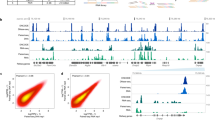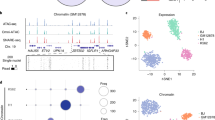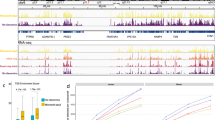Abstract
Joint profiling of chromatin accessibility and gene expression from the same single cell provides critical information about cell types in a tissue and cell states during a dynamic process. Here, we develop in situ sequencing hetero RNA–DNA-hybrid after assay for transposase-accessible chromatin-sequencing (ISSAAC-seq), a highly sensitive and flexible single-cell multi-omics method to interrogate chromatin accessibility and gene expression from the same single nucleus. We demonstrated that ISSAAC-seq is sensitive and provides high quality data with orders of magnitude more features than existing methods. Using the joint profiles from over 10,000 nuclei from the mouse cerebral cortex, we uncovered major and rare cell types and cell-type specific regulatory elements and identified heterogeneity at the chromatin level within established cell types defined by gene expression. Finally, we revealed distinct dynamics and relationships of gene expression and chromatin accessibility during an oligodendrocyte maturation trajectory.
This is a preview of subscription content, access via your institution
Access options
Access Nature and 54 other Nature Portfolio journals
Get Nature+, our best-value online-access subscription
$29.99 / 30 days
cancel any time
Subscribe to this journal
Receive 12 print issues and online access
$259.00 per year
only $21.58 per issue
Buy this article
- Purchase on Springer Link
- Instant access to full article PDF
Prices may be subject to local taxes which are calculated during checkout



Similar content being viewed by others
Data availability
The raw sequencing data generated in this study has been deposited at ArrayExpress under the accession number E-MTAB-11264. External data from previously published studies are available from the Gene Expression Omnibus: sci-CAR-seq (GSE117089), SNARE-seq (GSE126074), Paired-seq (GSE130399) and SHARE-seq (GSE140203). Source data are provided with this paper.
Code availability
The code used for the data processing and analysis mentioned in the method section is available on the GitHub repository https://github.com/dbrg77/ISSAAC-seq.
References
Tang, F. et al. mRNA-seq whole-transcriptome analysis of a single cell. Nat. Methods 6, 377–382 (2009).
Macosko, E. Z. et al. Highly parallel genome-wide expression profiling of individual cells using nanoliter droplets. Cell 161, 1202–1214 (2015).
Klein, A. M. et al. Droplet barcoding for single-cell transcriptomics applied to embryonic stem cells. Cell 161, 1187–1201 (2015).
Zheng, G. X. Y. et al. Massively parallel digital transcriptional profiling of single cells. Nat. Commun. 8, 14049 (2017).
Cao, J. et al. The single-cell transcriptional landscape of mammalian organogenesis. Nature 566, 496–502 (2019).
Hagemann-Jensen, M. et al. Single-cell RNA counting at allele and isoform resolution using Smart-seq3. Nat. Biotechnol. 38, 708–714 (2020).
Buenrostro, J. D. et al. Single-cell chromatin accessibility reveals principles of regulatory variation. Nature 523, 486–490 (2015).
Cusanovich, D. A. et al. Multiplex single-cell profiling of chromatin accessibility by combinatorial cellular indexing. Science 348, 910–914 (2015).
Chen, X., Miragaia, R. J., Natarajan, K. N. & Teichmann, S. A. A rapid and robust method for single cell chromatin accessibility profiling. Nat. Commun. 9, 5345 (2018).
Chen, X. et al. Joint single-cell DNA accessibility and protein epitope profiling reveals environmental regulation of epigenomic heterogeneity. Nat. Commun. 9, 4590 (2018).
Lake, B. B. et al. Integrative single-cell analysis of transcriptional and epigenetic states in the human adult brain. Nat. Biotechnol. 36, 70–80 (2018).
Satpathy, A. T. et al. Massively parallel single-cell chromatin landscapes of human immune cell development and intratumoral T cell exhaustion. Nat. Biotechnol. 37, 925–936 (2019).
Lareau, C. A. et al. Droplet-based combinatorial indexing for massive-scale single-cell chromatin accessibility. Nat. Biotechnol. 37, 916–924 (2019).
Stoeckius, M. et al. Simultaneous epitope and transcriptome measurement in single cells. Nat. Methods 14, 865–868 (2017).
Peterson, V. M. et al. Multiplexed quantification of proteins and transcripts in single cells. Nat. Biotechnol. 35, 936–939 (2017).
Stuart, T. & Satija, R. Integrative single-cell analysis. Nat. Rev. Genet. 20, 257–272 (2019).
Hao, Y. et al. Integrated analysis of multimodal single-cell data. Cell 184, 3573–3587.e29 (2021).
Argelaguet, R., Cuomo, A. S. E., Stegle, O. & Marioni, J. C. Computational principles and challenges in single-cell data integration. Nat. Biotechnol. 39, 1202–1215 (2021).
Zhu, C. et al. An ultra high-throughput method for single-cell joint analysis of open chromatin and transcriptome. Nat. Struct. Mol. Biol. 26, 1063–1070 (2019).
Ma, S. et al. Chromatin potential identified by shared single-cell profiling of RNA and chromatin. Cell 183, 1103–1116.e20 (2020).
Liu, L. et al. Deconvolution of single-cell multi-omics layers reveals regulatory heterogeneity. Nat. Commun. 10, 470 (2019).
Chen, S., Lake, B. B. & Zhang, K. High-throughput sequencing of the transcriptome and chromatin accessibility in the same cell. Nat. Biotechnol. 37, 1452–1457 (2019).
Cao, J. et al. Joint profiling of chromatin accessibility and gene expression in thousands of single cells. Science 361, eaau0730 (2018).
Zhu, C. et al. Joint profiling of histone modifications and transcriptome in single cells from mouse brain. Nat. Methods 18, 283–292 (2021).
Mimitou, E. P. et al. Scalable, multimodal profiling of chromatin accessibility, gene expression and protein levels in single cells. Nat. Biotechnol. 39, 1246–1258 (2021).
Clark, S. J. et al. scNMT-seq enables joint profiling of chromatin accessibility DNA methylation and transcription in single cells. Nat. Commun. 9, 781 (2018).
Swanson, E. et al. Simultaneous trimodal single-cell measurement of transcripts, epitopes, and chromatin accessibility using TEA-seq. eLife 10, e63632 (2021).
Xiong, H., Luo, Y., Wang, Q., Yu, X. & He, A. Single-cell joint detection of chromatin occupancy and transcriptome enables higher-dimensional epigenomic reconstructions. Nat. Methods 18, 652–660 (2021).
Guo, F. et al. Single-cell multi-omics sequencing of mouse early embryos and embryonic stem cells. Cell Res. 27, 967–988 (2017).
Rooijers, K. et al. scDam&T‐seq combines DNA adenine methyltransferase-based labeling of protein-DNA contact sites with transcriptome sequencing to analyze regulatory programs in single cells. Nat. Biotechnol. 37, 766–772 (2019).
Xing, Q. R. et al. Parallel bimodal single-cell sequencing of transcriptome and chromatin accessibility. Genome Res 30, 1027–1039 (2020).
Di, L. et al. RNA sequencing by direct tagmentation of RNA/DNA hybrids. Proc. Natl Acad. Sci. USA 117, 2886–2893 (2020).
Lu, B. et al. Transposase assisted tagmentation of RNA/DNA hybrid duplexes. eLife 9, e54919 (2020).
Xu, W. et al. A plate-based single-cell ATAC-seq workflow for fast and robust profiling of chromatin accessibility. Nat. Protoc. 16, 4084–4107 (2021).
Rosenberg, A. B. et al. Single-cell profiling of the developing mouse brain and spinal cord with split-pool barcoding. Science 360, eaam8999 (2018).
Ding, J. et al. Systematic comparison of single-cell and single-nucleus RNA-sequencing methods. Nat. Biotechnol. 38, 737–746 (2020).
Becht, E. et al. Dimensionality reduction for visualizing single-cell data using UMAP. Nat. Biotechnol. 37, 38–44 (2019).
Tasic, B. et al. Shared and distinct transcriptomic cell types across neocortical areas. Nature 563, 72–78 (2018).
Stuart, T. et al. Comprehensive integration of single-cell data. Cell 177, 1888–1902.e21 (2019).
Tasic, B. et al. Adult mouse cortical cell taxonomy revealed by single cell transcriptomics. Nat. Neurosci. 19, 335–346 (2016).
Aibar, S. et al. SCENIC: single-cell regulatory network inference and clustering. Nat. Methods 14, 1083–1086 (2017).
Factor, D. C. et al. Epigenomic comparison reveals activation of ‘seed’ enhancers during transition from naive to primed pluripotency. Cell Stem Cell 14, 854–863 (2014).
Bevington, S. L. et al. Inducible chromatin priming is associated with the establishment of immunological memory in T cells. EMBO J. 35, 515–535 (2016).
Ziffra, R. S. et al. Single-cell epigenomics reveals mechanisms of human cortical development. Nature 598, 205–213 (2021).
Qiu, X. et al. Reversed graph embedding resolves complex single-cell trajectories. Nat. Methods 14, 979–982 (2017).
Rop, F. V. D. et al. Hydrop enables droplet-based single-cell ATAC-seq and single-cell RNA-seq using dissolvable hydrogel beads. eLife 11, e73971 (2022).
Chen, A. F. et al. NEAT-seq: simultaneous profiling of intra-nuclear proteins, chromatin accessibility and gene expression in single cells. Nat. Methods 19, 547–553 (2022).
Renaud, G., Stenzel, U., Maricic, T., Wiebe, V. & Kelso, J. deML: robust demultiplexing of Illumina sequences using a likelihood-based approach. Bioinformatics 31, 770–772 (2015).
Köster, J. & Rahmann, S. Snakemake—a scalable bioinformatics workflow engine. Bioinformatics 28, 2520–2522 (2012).
Li, H. & Durbin, R. Fast and accurate short read alignment with Burrows–Wheeler transform. Bioinformatics 25, 1754–1760 (2009).
Kaminow, B., Yunusov, D. & Dobin, A. STARsolo: accurate, fast and versatile mapping/quantification of single-cell and single-nucleus RNA-seq data. Preprint at bioRxiv https://doi.org/10.1101/2021.05.05.442755 (2021).
Zhang, H. et al. Fast alignment and preprocessing of chromatin profiles with Chromap. Nat. Commun. 12, 6566 (2021).
Waltman, L. & Eck, N. Jvan A smart local moving algorithm for large-scale modularity-based community detection. Eur. Phys. J. B. 86, 471 (2013).
Wolf, F. A., Angerer, P. & Theis, F. J. SCANPY: large-scale single-cell gene expression data analysis. Genome Biol. 19, 15 (2018).
Stuart, T., Srivastava, A., Madad, S., Lareau, C. A. & Satija, R. Single-cell chromatin state analysis with Signac. Nat. Methods 18, 1333–1341 (2021).
Zhang, Y. et al. Model-based analysis of ChIP-seq (MACS). Genome Biol. 9, R137 (2008).
Heinz, S. et al. Simple combinations of lineage-determining transcription factors prime cis-regulatory elements required for macrophage and B cell identities. Mol. Cell 38, 576–589 (2010).
Acknowledgements
We thank all members from the Chen and Jin laboratories for the helpful discussion of the project. We also thank W. Chen and H. Cui from SUSTech for the helpful advice on the experiments. We thank X. Lu from SUSTech Core Research Facilities for the excellent support of FACS. The computational work was supported by Center for Computational Science and Engineering at Southern University of Science and Technology. Figures 1a and 2a were created with BioRender.com. This study was supported by National Key R&D Program of China (grant no. 2021YFF1200900 to W.J., X.C. and N.H.), National Natural Science Foundation of China (grant nos. 32170646 and 81872330 to W.J.), Guangdong Basic and Applied Basic Research Foundation (grant no. 2021B1515120070 to X.C.), Shenzhen Innovation Committee of Science and Technology (grant no. ZDSYS20200811144002008 to Shenzhen Key Laboratory of Gene Regulation and Systems Biology, to K.S., W.J. and X.C.), Shenzhen Science and Technology Program (grant no. KQTD20180411143432337 to W.J.), Shenzhen-Hong Kong Institute of Brain Science-Shenzhen Fundamental Research Institutions (grant no. 2021SHIBS0002 to K.S.) and Cambridge-SU Joint Research Center for Genomic Resources (grant no. 2017B01012 to X.C.). The funders had no role in study design, data collection and analysis, decision to publish or preparation of the manuscript.
Author information
Authors and Affiliations
Contributions
X.C. and W.J. conceived the project. X.C., W.X. and W.J. designed the protocol and experiments. W.X. performed the experiments with help from Y.C., N.H., Q.Z., X.W. and Y.H. W.Y. carried out the computational analysis with help from Y.Z., W.X., X.C., W.J. and K.S. X.C., W.J., K.S. and N.H. supervised the entire project. All authors contributed to the writing.
Corresponding authors
Ethics declarations
Competing interests
W.X., N.H., W.J. and X.C. have filed a patent application related to this work. The remaining authors declare no competing interests.
Peer review
Peer review information
Nature Methods thanks Ansuman Satpathy, Caleb Lareau, Kun Zhang and the other, anonymous, reviewer(s) for their contribution to the peer review of this work. Peer reviewer reports are available. Primary Handling Editor: Lei Tang, in collaboration with the Nature Methods team.
Additional information
Publisher’s note Springer Nature remains neutral with regard to jurisdictional claims in published maps and institutional affiliations.
Extended data
Extended Data Fig. 1 The plate-based (FACS) ISSAAC-seq workflow.
Schematic view of the plate-based (FACS) ISSAAC-seq workflow and adaptor configurations.
Extended Data Fig. 2 The droplet-based ISSAAC-seq workflow.
Schematic view of the droplet-based ISSAAC-seq workflow and adaptor configurations using 10x Chromium.
Extended Data Fig. 3 Experimental tests and benchmarking of ISSAAC-seq.
a and b, Assessment of ISSAAC-seq RNA data. Distributions of total UMIs (a) and numbers of detected genes (b) from indicated conditions performed on the E14 mouse embryonic stem cells. Pro, Protector RNase inhibitor. Ribo, RiboLock RNase inhibitors. c-e, Assessment of ISSAAC-seq ATAC data. Distributions of unique nuclear fragments (c), fraction of reads in peaks (FRiP) (d) and mitochondrial content (e) from indicated conditions performed on the E14 mouse embryonic stem cells. Boxplots show median with the top and bottom edges of the box representing the 75th and 25th percentiles, respectively. The whiskers represent the most extreme values that are within 1.5 times the interquartile range of the 25th and 75th percentiles. Outliers outside the whiskers are not shown. f, UCSC genome browser tracks of aggregated scATAC-seq signal from indicated conditions. g, Species mixing experiments of ISSAAC-seq using HEK293T and NIH3T3 cells.
Extended Data Fig. 4 ISSAAC-seq experimental results from different cell lines and PBMCs.
a, Examples of a typical FACS based workflow using K562 cells. FSC-A and SSC-A were used to select intact nuclei (P1). FSC-A and FSC-W were used to select singlets (P2). DAPI-A was used to select DAPI positive nuclei (P3). b, DNA electrophoresis of typical ISSAAC-seq libraries from the FACS (left) and droplet (right) workflow using K562 cells. c and d, Fragment size (c) and Tn5 insertion frequency (d) of ATAC data using different methods in the indicated cell lines. e, Quality metrics of the ISSAAC-seq PBMC data. f, Genomic distribution of reads from RNA data using different methods. g, Distributions of the numbers of UMIs using different methods performed in the indicated cell lines and PBMCs. Boxplots show median with the top and bottom edges of the box representing the 75th and 25th percentiles, respectively. The whiskers represent the most extreme values that are within 1.5 times the interquartile range of the 25th and 75th percentiles. Outliers outside the whiskers are not shown. The exact number of cells can be found in the Source Data.
Extended Data Fig. 5 UCSC genome browser tracks of single cell aggregates from ISSAAC-seq.
a, Visual comparisons of SHARE-seq, ISSAAC-seq and the 10x Multiome kit from K562 cells. Cell numbers are the same as in Fig. 1b. b, Visualisation of ATAC and RNA signals from single cell aggregates of ISSAAC-seq (FACS) in H1 (Day 3 upon mesoderm differentiation) and E14 (Day 4 upon EB differentiation) cells around the BRACHYURY and MIXL1 genes. c, UMAP projection of ISSAAC-seq PBMCs.
Extended Data Fig. 6 Computational pipeline for the data processing of droplet-based ISSAAC-seq.
a, Flow chart of the computational pipeline to process mouse cortex data. b, Cell barcode qualities and the number of nuclei returned by the pipeline in each step.
Extended Data Fig. 7 ISSAAC-seq ATAC and RNA data comparison.
a, UMAP projection of mouse cortex cells with ISSAAC-seq ATAC data colored by ATAC clusters (left) and batches (right). b, Ribbon plot showed the relationship between all RNA clusters and all ATAC clusters. c, UMAP projection of mouse cortex cells with ISSAAC-seq RNA data, highlighted by RNA cluster R2 Ex-L4/5 IT neurons (left) and ATAC cluster A2, A3 and A9 (right). d, UMAP projection of Ex-L4/5 IT neurons (RNA cluster R2) colored by RNA subclusters (left) and ATAC clusters. e, Gene ontology of the top 50 differentially expressed genes among A2, A3 and A9 clusters within the Ex-L4/5 IT neurons. Hypergeometric tests were used to derive the p-values, and the Benjamini-Hochberg Procedure was used to adjust multiple comparisons. f, SCENIC analysis of regulon (TF) activity in A2, A3 and A9 cells.
Extended Data Fig. 8 The prediction probability of each single cell based on the Allen Brain reference data using the label transfer function from Seurat.
Each row is a predicted label. Each column is a cell. The cluster identify of each cell is indicated at the bottom using the same colour code as in Fig. 2c.
Extended Data Fig. 9 UMAP projection of ISSAAC-seq RNA data coloured by the expression levels of indicated genes or batches.
A total of 24 marker genes are shown. Batch (biological replicates) information is shown in the bottom right plot.
Supplementary information
Supplementary Information
Supplementary Tables 1 and 2, Notes 1–4, References and Protocols 1 and 2.
Supplementary Tables
Supplementary Tables 3 and 4.
Source data
Source Data Fig. 1
Source data for the boxplot and the violinplot in Fig. 1c,d.
Source Data Fig. 2
Source data for the boxplot and the violinplot in Fig. 2b.
Rights and permissions
Springer Nature or its licensor holds exclusive rights to this article under a publishing agreement with the author(s) or other rightsholder(s); author self-archiving of the accepted manuscript version of this article is solely governed by the terms of such publishing agreement and applicable law.
About this article
Cite this article
Xu, W., Yang, W., Zhang, Y. et al. ISSAAC-seq enables sensitive and flexible multimodal profiling of chromatin accessibility and gene expression in single cells. Nat Methods 19, 1243–1249 (2022). https://doi.org/10.1038/s41592-022-01601-4
Received:
Accepted:
Published:
Issue Date:
DOI: https://doi.org/10.1038/s41592-022-01601-4
This article is cited by
-
txci-ATAC-seq: a massive-scale single-cell technique to profile chromatin accessibility
Genome Biology (2024)
-
Nano-CUT&Tag for multimodal chromatin profiling at single-cell resolution
Nature Protocols (2024)
-
Advances in single-cell omics and multiomics for high-resolution molecular profiling
Experimental & Molecular Medicine (2024)
-
Representing and extracting knowledge from single-cell data
Biophysical Reviews (2024)
-
Beyond single cells: microfluidics empowering multiomics analysis
Analytical and Bioanalytical Chemistry (2024)



